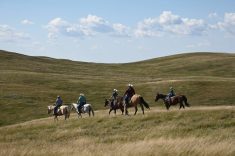We were excited last fall to start a few young farmers out with some of the best ewe lambs we had ever raised. It’s been a long time since our first baby season but all the conversations we have been having with these new farmers has made me realize that we really have learned a lot and there is a need for me to share.
It is very important for the females’ body condition score to be evaluated at least one month prior to parturition, but preferably two. This allows enough time to make dietary changes needed to get them into a favourable body condition score (BCS).
Read Also

Harvest wraps up and fall work begins
At the Eppich famly ranch in western Saskatchewan, the fall harvest was successful with few breakdowns, cows and calves have been sorted and a new tractor has arrived
A BCS estimates condition of muscling and fat development by touch. Scoring is based on feeling the level of muscling and fat deposition over and around the vertebrae in the loin region. In addition to the central spinal column, loin vertebrae have a vertical bone protrusion (spinous process) and short horizontal bones on each side (transverse process, technically, but we call them short ribs). The system used in Canada is a five-point scale with one being emaciated and five being obese.
DETERMINING BCS
Each ewe should be caught and, using the fingers feel for the spine, in the center of the sheep’s back, behind its last rib and in front of its hipbone. Try and get a mental image of her skeletal structure in relation to what is being felt. Next, feel for the tips of the transverse process (short ribs). With the heel of your hand on top of the spine, the tips of your fingers should be in line with these. The harder you have to push to feel these the more cover there is on the bone so the higher her BCS. Feel over the top of her spine for spring of muscle.
BCS score 1 (emaciated). Spine is sharp and prominent. Loin eye muscle is shallow with no fat cover. The short ribs are sharp; one can pass fingers under ends. It is possible to feel each individual vertebra.
BCS score 2 (thin). Spine is sharp and easily felt. Loin eye muscle has little fat cover but is full. Short ribs are smooth and slightly rounded. It is possible to pass fingers under the ends of the transverse processes with a little pressure.
BCS score 3 (medium). Spine feels smooth and individual vertebra only felt under pressure. Short ribs are smooth and well covered, and firm pressure is needed to feel over the ends. Loin eye muscle is full with some fat cover.
BCS score 4 (fat). Spine can be detected only with pressure as a hard line. Short ribs also cannot be felt. Loin eye muscle is full with a thick fat cover.
BCS score 5 (obese). Spine cannot be felt even with pressure. There is a depression between fat where spine would normally be felt. Short ribs cannot be detected. Loin eye muscle is very full with a very thick fat cover.
MANAGEMENT PRIOR TO LAMBING
If the ewes are too fat then reducing the grain or adjusting the hay they are being fed will do the trick. If they are thin however an increase in the ration will be needed. On average, a difference of one unit of condition score is equivalent to about 13 per cent of the live weight of a ewe at a moderate (three to 3.5) body condition score. Therefore a ewe with a maintenance weight of 150 pounds would need to gain approximately 20 pounds to go from a body condition score of 2.5 to 3.5. This is why we BCS the ewes two months prior to lambing when we still have time to adjust their ration. We have found that a ewe that is not in a BCS of 2.5 to three at lambing has a greater risk of health problems. We have also found that they will not milk as well because they do not have the energy stores to do so. This results in smaller weaning weights of lambs.
We have found that thinner ewes benefit from being moved to the ewe lamb pen for the rest of the pregnancy. Approximately 70 per cent of fetal growth is during the last six weeks of gestation. All ewes, regardless of BCS, require 50 per cent more feed during the last five weeks of gestation. For the thinner ones this is even more critical in order to have healthy vigourous lambs and sufficient milk production. It is also vital to remember that any feed changes should be done slowly in order to avoid bloating or other digestive upsets. Once we have the thinner ewes on a better diet we maintain them at that amount till they either attain a BCS of 3.5 or pasture arrives. Green grass is the best feed we have ever found.
DebbieChikouskyfarmsnearNarcisse,Man.
Visitherwebsite www.chikouskyfarms.com














